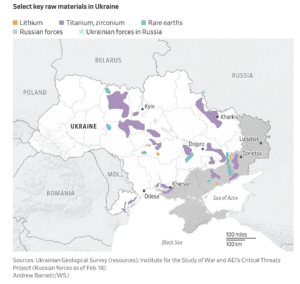The United States is pushing to secure a high-stakes minerals deal with Ukraine, one that could reshape the global supply chain for critical minerals and help the U.S. recover the billions spent supporting Ukraine’s war efforts. As negotiations between President Donald Trump and Ukrainian President Volodymyr Zelenskyy seemingly broke down, the prospect of U.S. access to Ukraine’s vast mineral deposits is becoming increasingly unlikely.
But if President Trump pushes, it won’t be surprising. This deal could not only help offset the financial costs of military aid but also boost America’s technological and economic future.
A Deal That Pays for Itself
Since the onset of the Russia-Ukraine war, the United States has provided approximately $100 billion in military and financial aid to Ukraine. Securing a minerals agreement would allow the U.S. to recoup some of that investment by tapping into Ukraine’s trillion-dollar mineral reserves. Initially, Trump suggested the U.S. should receive up to $500 billion in future revenues from Ukraine’s resource development, though negotiations have since settled on a more measured approach.

Ukraine is home to 20 of the 50 minerals the U.S. government classifies as critical for national security and economic growth. This includes lithium, graphite, titanium, uranium, and rare earth elements—materials essential for everything from electric vehicles and batteries to defense systems and advanced electronics.
The Race for Ukraine’s Resources
Ukraine’s mineral wealth is considered one of the largest untapped reserves in Europe. Before Russia’s full-scale invasion in 2022, the country produced 6% of the world’s titanium—a metal crucial for missiles, aircraft, and naval ships. It also holds 3% of the world’s lithium, a key element in battery technology, which is projected to see soaring demand in the coming decade.
However, much of Ukraine’s mineral wealth remains untapped due to outdated Soviet-era geological studies and the need for substantial investment in modern mining infrastructure. Companies like UkrLithiumMining estimate that hundreds of millions of dollars are required to bring even a single lithium project online.
“If the war ended tomorrow, lithium would be the priority,” said George Ingall, an analyst at Benchmark Minerals Intelligence. But as much as 40% of Ukraine’s critical mineral deposits are in Russian-occupied territories, adding another layer of complexity to the deal.
A Strategic Advantage for the U.S.
Beyond the economic benefits, gaining access to Ukraine’s minerals would help the U.S. reduce its dependence on China, which currently dominates the global supply of rare earth elements and other critical minerals. Trump has been vocal about securing alternative sources, previously suggesting that the U.S. could acquire Greenland for its mineral wealth. Now, Ukraine presents a more realistic and immediate opportunity.
The stakes are high:
- Lithium and battery metals are crucial for the future of electric vehicles and renewable energy.
- Titanium is indispensable for aerospace and defense applications.
- Rare earth elements are used in everything from smartphones to missile guidance systems.
- With the global demand for these materials rising, a U.S.-Ukraine minerals deal could fortify America’s supply chain, ensuring economic and national security for decades to come.
The Challenges Ahead
Despite the deal’s potential, several obstacles remain:
- Security Risks: Much of Ukraine’s resource-rich territory is still under Russian occupation, complicating extraction efforts.
- High Investment Costs: Mining and refining critical minerals require billions in infrastructure investments.
- Geopolitical Uncertainty: Russia may use Ukraine’s mineral wealth as a bargaining chip in future peace talks, making long-term control uncertain.
Even so, industry experts argue that Ukraine’s minerals could become the foundation for the country’s post-war recovery, much like Iraq’s oil industry following years of conflict.
A Deal Worth Pursuing
Securing Ukraine’s minerals is more than just a financial win—it’s a strategic necessity. With China tightening its grip on global supply chains and the U.S. racing to secure domestic sources of critical minerals, Ukraine offers a rare opportunity to strengthen America’s economic and technological future.
If structured correctly, this deal could allow the U.S. to recover a significant portion of the aid spent on Ukraine, while ensuring long-term access to the raw materials that will power the next generation of innovation.
With negotiations intensifying, the question is no longer whether the U.S. should secure Ukraine’s mineral wealth—but how quickly it can be done.







